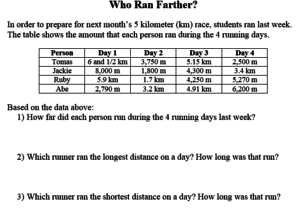Convert among different-sized standard measurement units (i.e., km, m, cm; kg, g; lb, oz.; l, ml; hr, min, sec) within a given measurement system (e.g., convert 5 cm to 0.05 m), and use these conversions in solving multi-step, real world problems.
Students are able to…
- Convert from one unit of measure to another unit of measure and justify their thinking when given a real world problem solving situation.
- Use the vocabulary associated with the metric and customary measurement.
- Use reasoning to determine if the converted units should be more or less than the original units.
Students are able to…because teachers:
- Provide students with hands-on measuring activities to help them have a better understanding of the relationship between units. All kinds of tools should be used, including rulers, yardsticks, tape measures, scales, cups, quarts, beakers, and so on. Experience with these hand-one tools will help students understand that the number of units relates to the size of the unit. With this understanding students will be able to determine whether they need to multiply or divide when making conversions.
- Engage students in problem solving situations that require them to convert units of measure.
- Allow students to discuss and justify their solutions to problem solving situations that require conversions.
- Model vocabulary usage with measurement term.
[divider] [/divider]
Questions to ask students:
- Ask students what operation they would use to change a larger unit to a smaller unit.
- Sample answer that indicates understanding: I would use multiplication because we will be changing a few larger units to many smaller units.
- Sample answer that indicates an incomplete understanding or misconception: I would divide because that will give me a smaller unit.
- Ask students how they know if they should multiply or divide when converting units.
- Sample answer that indicates understanding: If we are converting a smaller unit to a larger unit, we should divide. If we convert a larger unit to a smaller unit, we should multiply.
- Ask students why converting metric units is easier than converting customary units.
- Sample answer that indicates understanding: metric units increase or decrease by powers of 10, customary units have harder numbers to convert like 3 feet in a yard or 12 inches in a foot.
[divider] [/divider]
FSA Notes
Cognitive Complexity Level: Level 2- Basic Application of Skills & Concepts
Achievement Level Descriptors:
Level 2: converts among different-sized standard measurement units within a given measurement system
Level 3: uses one conversion to solve multistep, real-world problems
Level 4: uses multiple conversions to solve multistep, real-world problems
Level 5: analyzes a conversion problem to identify an error
Achievement Level Descriptors:
Measurement values may be whole, decimal, or fractional values.
Conversions must be within the same system.
[divider] [/divider]
Additional Resources:
Additional in depth content knowledge:
Video: Converting units- centimeters to meters
[divider] [/divider]
Sample Formative Assessment Task:
Michael is measuring fabric for the costumes of a school play. He needs 11.5
meters of fabric. He has 28.5 centimeters of fabric. How many more centimeters
of fabric does he need?
[divider] [/divider]
